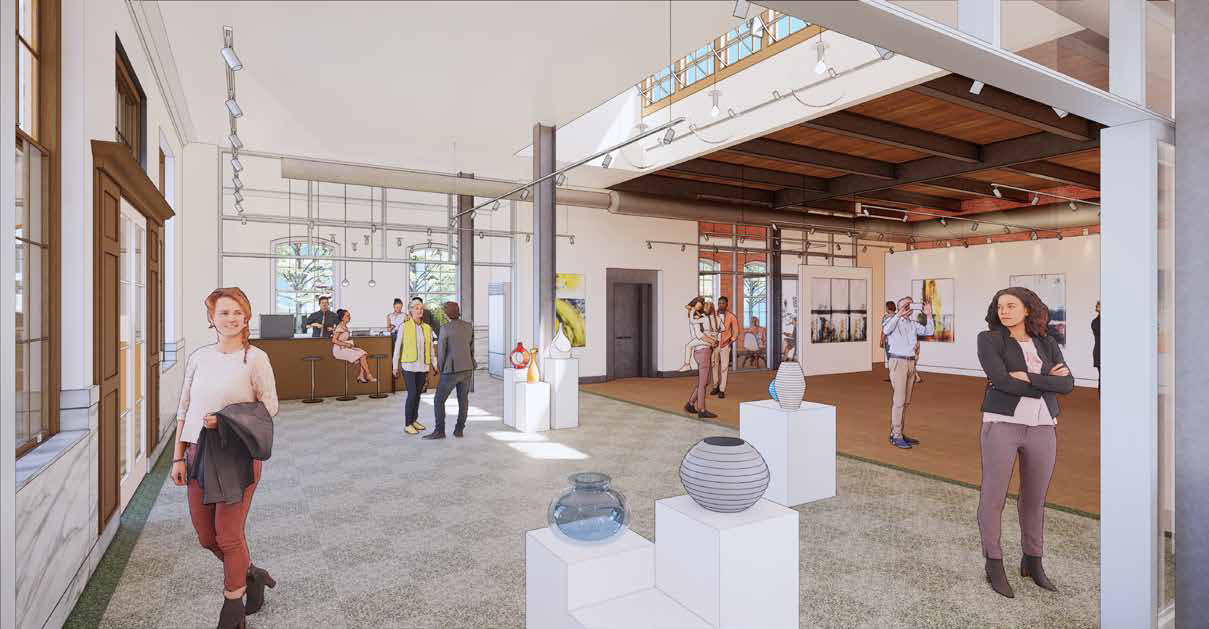Auburn’s Parks, Arts and Recreation Department laid on city leaders Sept. 14 their plan to transform the former post office building on Auburn Avenue into the future Auburn Arts and Culture Center.
It will be an 8,000-square-foot energy hub for the arts and for community gatherings downtown, replete with gallery spaces and places for artists to take classes and work, they said.
And when the work is done, they expect the result will be to make Auburn’s downtown what everyone has wanted it to be for years: an exciting place to be.
“So that we can have a ‘there there’ in our downtown,” said Auburn Parks, Arts and Recreation Director Daryl Faber.
While phase 1 of the project will center on the upstairs, the roof and the cupola, here’s a bit of the big picture, as presented to the Auburn City Council by Roy Johnston Architects, consultant Lena Wiies and Allison Hyde , arts coordinator for the Arts, Parks and Recreation Department who is already programming what to do with all the space, as follows.
• Studio space, to include a visiting artist, from whom locals can take classes and watch work.
• Public programming throughout the year, to include free events for the community, like lectures, artists’ talks and small-scale performances and events.
• Partnerships with local organizations and the Auburn School District to create after-school classes and programs.
• Rental space of a large gallery for gatherings.
• A small gift shop and store where artists can sell their creations.
• Rotating exhibitions in the main floor gallery space and a small, independent gallery space called The Vault, which will use the original post office vault.
• A small cafe for catering and events.
Small grants have already allowed the city to fix the windows, Faber said, but as a historic building, every bit of work on the outside must meet the approval of the county’s historic landmarks commission.
So far, Faber said, the city has landed $900,000 worth of grants, with another application in right now to 4 Culture, King County’s funding arm. As Faber noted, 4 Culture has been warmly supportive of what the city has done over the years in terms of the performing arts and building renovation.
The largest grant awarded the city to date came from the State Department of Commerce, thanks, Faber said, to 47th District Rep. Pat Sullivan.
“Once we got (the money) in there, we had to start spending money or lose it,” Faber said.
Preliminary to any work on the project, the city hosted community meetings to percolate ideas, then it went to town with old drawings from 1937 to see what parts of the building could be saved. Among those parts were the original terrazzo floor and the original windows, tricked out with old-timey pull chains.
Once workers had removed the suspended ceiling, Faber said, they found the original, cedar plank ceiling, and with the suspended ceiling outta there, the gloom lifted, and the building suddenly took on a much more cheerful mien.
And when workers removed the cramped quarters where the health clinic’s nurses worked, Faber continued, the entire building lit up.
Built in 1937 and funded in part by the Depression-era Works Progress Administration program, the building officially opened in 1938 as a United States Post Office, which it remained until 1963, when the federal government built a newer, larger post office a few block to the west.
In 1964, the King County Health Department bought the vacant building and operated it as a public clinic until 2009. After years of negotiations with King County, the city of Auburn finally closed on the acquisition in 2016, and ever since then has been working on design and raising money for the project.
“We have a multi-faceted program plan that aims to just energize the downtown and to engage the community in a lot of arts and cultural programming to create vitality, a sense of community and engagement in a variety of ways,” said Hyde. “And especially with two new, high-rise buildings in the works, we have a really growing urban community that I think is going to be able to benefit from and help this place flourish.”
By the numbers
Here’s where the money for the future Auburn Arts and Culture Center has come from to date:
• 4Culture Building for Culture: 2016-2019 for Schematic designs, irrigation & phase 1 interior demolition: $200,000
• 4Culture preservation special projects: 2017-2018 for architectural services and planning design: $10,000
• 4Culture landmarks capital 2017-2018 for historic window restoration: $10,000
• 4Culture Arts facilities grant 2017: $90,000
• Multicare grant: $15,000
• 4Culture building for equity arts facilities grant 2019: $50,000
• State of Washington Dept. of Commerce 2019: $490,000
• 4Culture Landmarks Capital: 2019 for wood floor and terrazzo flooring rehabilitation: $23,000
• 4Culture preservation emergency and unforseen: 2020 cupola rehabilitation: $10,000.
• Total project grants to date: $898,000
Timeline
Auburn Arts and Culture Center, phase one main floor project timeline:
• August 2016: city buys building from King County, fundraising and grant writing efforts ongoing
• September-November 2016: community outreach
• December 2016: initial design schematics and overall cost estimates
• 2018: historic window restoration
• January to March 2019: interior demolition
• December 2020: final design documents, bidding, contract award
• Spring 2021: phase one renovations under construction
• End of 2021: phase one grand opening
• 2022-2023: phase two renovations



